It was early March, and another cloudless 70 oF day had arrived in Los Angeles. Trees were leafing out, flowers were sprouting across nearby deserts, and spring was on the horizon. My mind, however, was wandering much farther north. Exactly one year ago I was on my way to Alaska’s north slope, with green aurouae dancing overhead. My destination was the end of the road – the town of Deadhorse – but more than 400 miles of ice, the Brooks Range and a succession of weather-related obstacles stood in my path. The temperature outside had dipped to -65 oF. My engine struggled to turn over, the transmission refused to shift, and windows froze shut. Snow drifts eventually closed the road, forcing a retreat to Fairbanks with my mission uncompleted. The journey, though, left me with memories of an incomparably desolate but pristine winter wilderness, a landscape that beckoned me to return. With more accommodating weather forecasted this year, I decided to do what any committed landscape photographer would do – try it again. To assist those interested in embarking on a similar journey, I thought I’d share what I learned along the way.
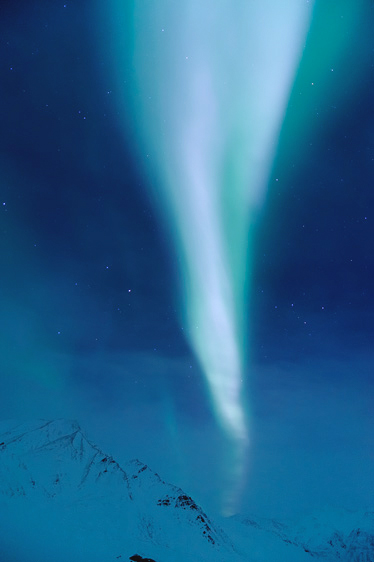
Purple Tornado (Nikon D700)
_________________________________________________________________
When To Visit
The arctic tends to be at its coldest in January and February. To give you a better sense for what that means, during one recent January the temperature in Coldfoot, a small encampment 240 miles south of Deadhorse, remained below -60 oF for 17 straight days. I recommend visiting in March, for reasons beyond avoiding accidental cryogenic suspension. Around the spring equinox, March 21, there will be roughly twelve hours of light and twelve hours of darkness, providing good opportunities for both daytime landscape photography and nighttime aurora photography. The aurora also tends to peak in intensity around the spring equinox (also the fall equinox, but the skies are more frequently clear in spring). Finally, for those interested in other unique photographic opportunities, Fairbanks currently hosts the world ice-carving championships in mid-March and the Iditarod sled dog race starts out of Anchorage around the same time.
_________________________________________________________________
Access To The Arctic
The principal avenue into the Alaskan arctic is the Dalton Highway, which crosses the Arctic Circle at milepost 115. The Dalton is a continuation of the Elliot Highway, which runs north out of Fairbanks, central Alaska’s main city. Fairbanks is a preferred point of entry and source of the provisions one needs to collect before venturing north. It is home to an international airport and has plenty of rental cars, grocery stores, sporting goods outfitters, and hotels. Those not wishing to drive north can, of course, arrange for bush plane flights into isolated arctic villages, but in my view the preferred mode of travel is by car. A car will enable greater freedom of exploration and, if all goes well, keep you warm in the process. A four wheel drive vehicle with winter tires is a necessity, while tire chains are probably not essential for passenger vehicles. Most of the rental companies strictly forbid travel on the Dalton during the summer, when flying pebbles and cracked windshields are rampant. This winter, however, the rental company I used (National) did not impose any such restriction.
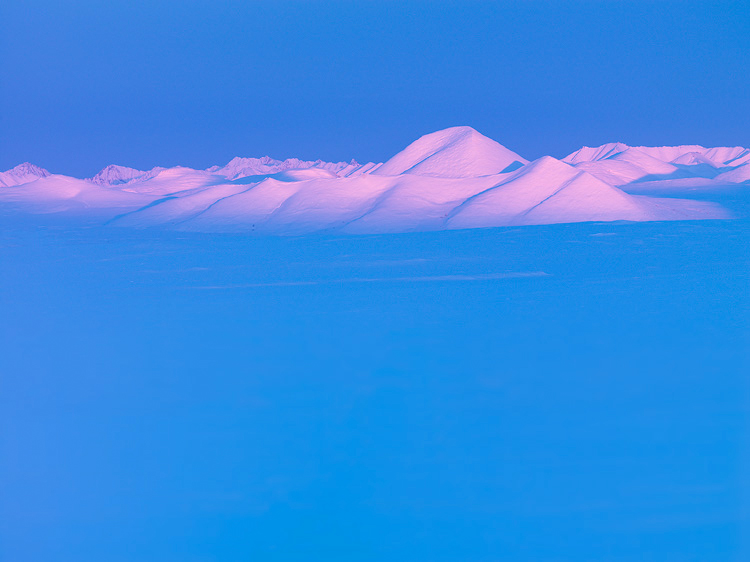
Floating Majesty (Hasselblad H3D-39)
_________________________________________________________________
Ecosystems Of Northern Alaska
The terrain transforms quite dramatically between Fairbanks and Deadhorse, from forests to mountains to tundra. More specifically, in the south there are expansive groves of leafless aspen. These groves eventually give way to forests of evergreen spruce mixed with leafless alder bushes. The northernmost spruce tree resides just past milepost 235, marked by a sign imploring passersby not to cut down the tree. Its predecessor reportedly perished from an ill-fated encounter with an axe. At mile 244 sits Atigun Pass, where the road passes over the crest of the Brooks range into a series of valleys bordered by imposing mountain peaks and, eventually, flat tundra with only occasional vegetation peeking out above the ice. For those in search of quintessential, minimalistic arctic landscapes, this is your realm. Most of my time was spent around Atigun pass and north, where I found the landscapes most photogenic.
_________________________________________________________________
Arctic Light
The arctic offers photographers far more than unusual terrain and wildlife. It offers exceptional light. During the winter, the sun remains low on the horizon throughout most of the day – that is, on the days where the sun rises at all. The golden hours last far longer than they do down south, often for multiple hours twice a day. The clarity of the atmosphere is also remarkable. One can often see for hundreds of miles, and the colors at sunrise and sunset are frequently more vivid than those in subarctic regions. This combination of ingredients creates the perfect storm for memorable landscape photography.
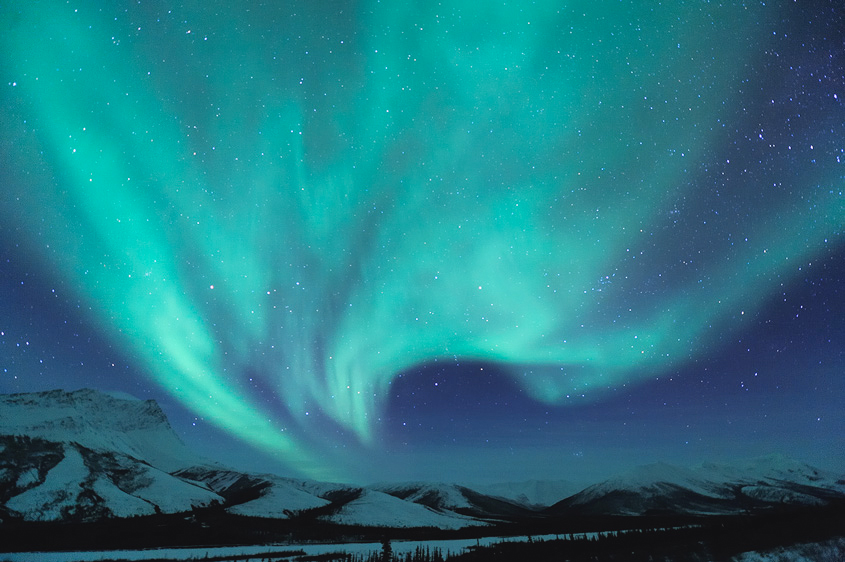
Bird Of Paradise (Nikon D700)
_________________________________________________________________
The Aurora Borealis
The aurora, for me, remains one of the primary attractions of the arctic. The winter aurorae in northern Alaska are prevalent and jaw-droppingly beautiful. A primer on aurora photography may be foundhere.
Having now explored nearly every reasonably accessible location in the triangle bounded by Fairbanks, Circle, and Deadhorse, my belief is that the optimal area for Alaskan aurora photography begins just south of Atigun pass and extends about 30 miles to the north. Atigun pass is the highest road pass in Alaska, at 4800 feet. The pass and surrounding regions are blanketed with snow throughout most of the year. The road in this area winds through a series of dramatic mountains that provide a superb foreground with which to anchor your aurora imagery. Additionally, Atigun pass is located far enough north that the aurorae regularly appear overhead, rather than low on the horizon as they more typically do down south. Overhead aurorae tend to be more photogenic, clearer and brighter because of reduced atmospheric interference, and more effectively illuminate the foreground. With an overhead aroura, foreground snow will generally take on the coloration of the aurora, whereas with aurorae low on the horizon the foreground will usually appear as a silhouette unless lit by the moon or light painting.
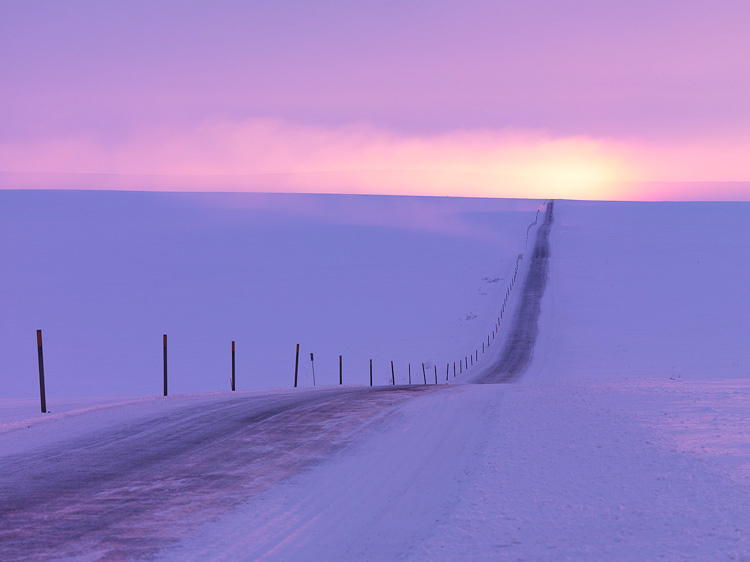
Road To The Sun (Hasselblad H3D-39)
_________________________________________________________________
The Hand Of Man
Landscape photographers, myself included, often go to great lengths to avoid even the slightest indicia of human existence in their imagery. The landscapes in the far north, though, can be extraordinarily minimalistic – sometimes nothing more than an undifferentiated field of white snow extending to the horizon. This is one of very few situations where I have affirmatively attempted to incorporate the “hand of man” into some of my photographs. The two most prominent man-made structures in this area are the Dalton Highway and, running generally parallel to it, the trans-Alaska pipeline. These structures can be used to your advantage, adding a sense of scale and perspective, and drawing viewers’ eyes through your frame.
_________________________________________________________________
Arctic Wildlife
Wildlife encounters in the arctic winter are few and far between. There are, nevertheless, a variety of interesting inhabitants you will likely be able to photograph along the way. Moose appear to prefer the protection of the trees and seemed to be clustered in the south. Musk ox, in contrast, appear to prefer the open tundra and coldest weather, and are most often found wandering in small herds within about 100 miles of Deadhorse. Between these extremes, I saw willow ptarmigans, red foxes, arctic hares, ravens and dahl sheep. Most impressive though was the central arctic caribou herd, with an estimated 67,000 caribou, wintering over just south of Atigun Pass. Even for those photographers exclusively in search of landscapes, these animals present a sense of scale and intrigue that can enhance your imagery.

Dahl Descending (Nikon D700)
________________________________________________________________
Cold Weather Photography
The frigid temperatures of the far north will take a toll not only on you, but on your equipment. One of the most significant affects is on battery life. My Nikon D700’s batteries last at least 2,000 actuations in normal conditions, but in the arctic winter were exhausted after about 25 frames. The conventional cold weather advice is to keep your battery warm by storing it in a jacket pocket while not in use, but that is not an adequate solution under extreme arctic conditions. I used multiple batteries and a charger, and rotated the batteries through the charging station when not in use.
Another major issue in the arctic is with condensation that occurs when moving your camera from an extremely cold environment (e.g., shooting outside) to a much warmer space (e.g., into a heated car). Particularly for non-weather-sealed equipment, including most medium format cameras and lenses, it is essential that the cold-to-warm transition be made very slowly. It only takes one misstep to generate trip-ending amounts of condensation inside your lenses and sensor. After shooting with my Hasselblad H3D, I transfer it to a camera bag that has also been outside, and only after sealing the bag do I move the bag and camera into the warmer car. The camera is then allowed to heat up, slowly and safely, within the bag. The one time I deviated from that procedure, I ended up with condensation underneath the filter covering the sensor, necessitating a lengthy visit to Denmark for repair. Although I have never experienced that (or any other) problem with my weather-sealed Nikon D700, out of an excess of caution I still use the same procedure for that camera.
In the arctic winter, you will almost certainly be shooting with gloves, and that raises another issue. There is a tension between having gloves thick enough to keep your hands warm, yet thin enough to allow you to operate your camera. I eventually opted for dexterity over comfort, and settled on a pair of thin glove liners that frequently left my fingers numb. If you are adverse to occasional frostbite, I’d encourage you to go with a different solution.
Finally, the landscapes of the far north invariably include broad expanses of snow. Don’t forget to adjust your exposure accordingly. Unless you’d like to end up with gray snow, in most situations you will want to dial in about one to one and a third stops of added exposure.
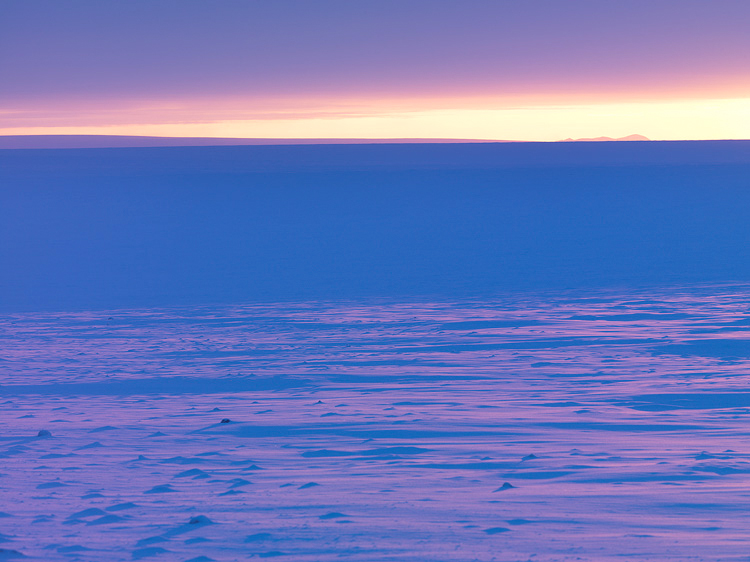
Last Rays (Hasselblad H3D-39)
_________________________________________________________________
Arctic Safety
The arctic is, obviously, an extraordinarily hostile environment. The weather is frigid, the roads are coated in ice, and the wildlife can be dangerous. Cell phone service is not available between Fairbanks and Deadhorse and, even if you could summon assistance, the nearest professional help would often be hours away. In this setting, even small mistakes can be extremely costly. Meticulous planning and care along the way are essential to ensuring a safe return.
Weather:
Weather reports in the arctic are few and far between, and unpredictable weather seems to be the order of the day. There are weather stations at Fairbanks and Deadhorse, as well as at Manley Hot Springs (to the west of the Dalton) and Central (to the southeast of the Dalton). You might get some general sense of what weather to expect by interpolating between these available datapoints. However, this will at best provide only a very rough approximation. Microclimates abound in the arctic. I regularly experienced temperature swings of more than 20 oF within a span of just a few miles, and temperatures did not consistently increase with decreasing altitude or latitude. When searching for a sleeping location at night, I used the car thermometer to seek out the warmest locations available and these “warm” spots seemed to move on a nightly basis.
Clothing:
My clothing progressed through several iterations before it was arctic-worthy. I recommend beginning with a few short night trips into the hills above Fairbanks, allowing yourself an opportunity to plug any remaining gaps in your outfit before heading to the remote north. Through experimentation I settled on a down-insulated parka and matching pants (Mountain Hardwear Absolute Zero), -40 oF rated boots (by Sorel), a wind-proof cap (by Mountain Hardwear) and three full-body sets of thick long underwear. This allowed me to sleep in the car without unbearable discomfort, as well as to spend up to eight consecutive hours photographing outside at -40 oF.
Fuel:
You will need gas not just to travel, but to keep your vehicle heated throughout the day and night. Gas is currently available 24 hours a day at both Coldfoot (milepost 175 of the Dalton) and Deadhorse (milepost 414). I spent most of my time about 100 miles north of Coldfoot, and strapped two five-gallon gas containers to the roof in order to reduce the frequency of resupply trips. Inexpensive gas cans and tie down straps are available at the Wal-Mart in Fairbanks. Depending on the temperatures you expect, you might also consider purchasing additives used to prevent your fuel from freezing. These additives are widely available, including at Wal-Mart and gas stations. The most popular comes in a bright yellow 12 ounce bottle under the trade name “Heat.”
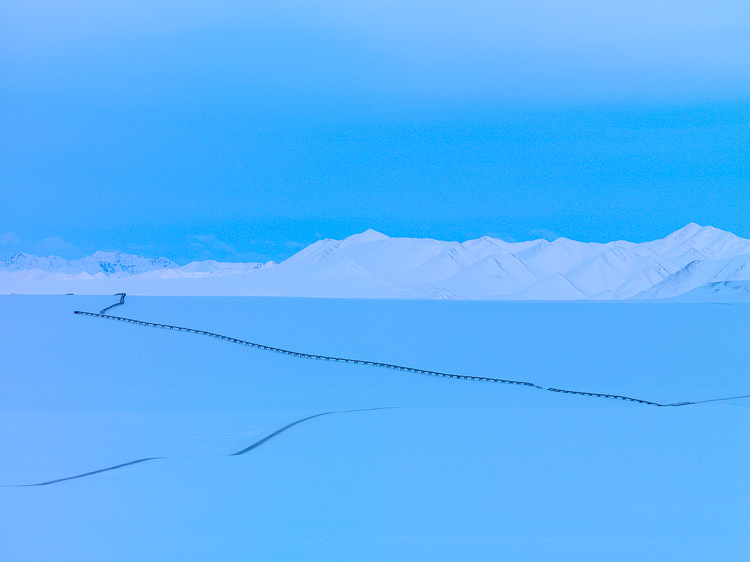
Road Meets Pipeline (Hasselblad H3D-39)
Food:
To ensure that your journey will end more happily than the Donner Expedition, I suggest loading up on non-perishable food in Fairbanks. The only food available before Deadhorse is at a truckstop in Coldfoot. The truckstop is staffed by some very friendly people who, to be charitable, do not excel in the kitchen. While eating trucker food in Coldfoot, you will be able to use their telephone (bring a calling card) to let your loved ones know that you haven’t frozen yet. Speaking of which, be mindful that any food placed on the floor of your car will likely freeze solid. I lost a bunch of bananas this way within just a couple of hours. This is undoubtedly why there are no monkeys in the arctic.
Emergency preparation:
The roads are slick and, because of snow cover, their edges are often not discernible. I recommend packing a tow rope, just in case you inadvertently exit the roadway. I only had to use mine once, but it was worth its weight in gold. Also, even if you don’t plan to sleep in the car (for the less adventurous, rooms are available at Coldfoot and Deadhorse), I suggest packing a cold weather sleeping bag. I purchased an inexpensive -20 oF rated bag at a local store and carried it with me, just in case I was stranded by mechanical problems. At least one good spare tire (many people recommend two) is also a necessity. A toolkit and general emergency supply kit are good ideas as well. To appease my wife, I also carried a satellite rescue beacon that I usually use for backcountry hiking, although this was probably overkill; there is at least occasional industrial traffic on the Dalton throughout the day and most of the night, and I would likely have been rescued by a passing trucker if my vehicle had broken down. Thankfully, in any event, it did not.

Aurora Over Atigun Pass (Nikon D700)
________________________________________________________________
Conclusion
My visit to the north was trying at times, but exceptionally rewarding and well worth the effort. The weather was cooperative, with temperatures that hovered around -20 oF and bottomed out at a mere -40 oF. I saw thousands of animals, none of which even attempted to eat me, and the most brilliant arourae of my life. My cameras and I made it all the way to Deadhorse and back, unscathed, and we’re hoping to return next winter. This is, of course, not a journey suited for everyone. To those of you compelled to photograph dramatic and rarely visited landscapes, in good physical condition, and willing to invest the energy necessary to prepare appropriately for an excursion of this sort, however, I encourage you to conduct further research and seriously consider visiting this corner of the world yourself.
August, 2010
Ben Hattenbach
________________________________________________________________
Ben Hattenbach
When not photographing remote landscapes, Ben Hattenbach is a partner at a Los Angeles-based law firm where his practice focuses on the trial of complex intellectual property disputes. More of his images of Alaska, and other regions, can be seen at http://www.benhattenbach.com.
To be perfectly clear, Ben is absolutely not a professional survivalist or arctic travel advisor. This article should be understood merely as a report on what he personally experienced, not as any sort of general purpose or comprehensive travel guide. You and your experiences could, obviously, be quite different. Before undertaking a trip even remotely resembling that described here it is imperative that you perform your own research, make your own determinations about whether a particular journey is suitable for you, and make your own decisions about what preparations are appropriate for any travels you elect to undertake.
You May Also Enjoy...
Canon 400mm DxO Tests
About 3 years ago I tested two different 400mm solution — theCanon 100-400 f/5.6LISzoom against the then brand newCanon 70-200mm f/2.8L with Canon 2X Extender.
